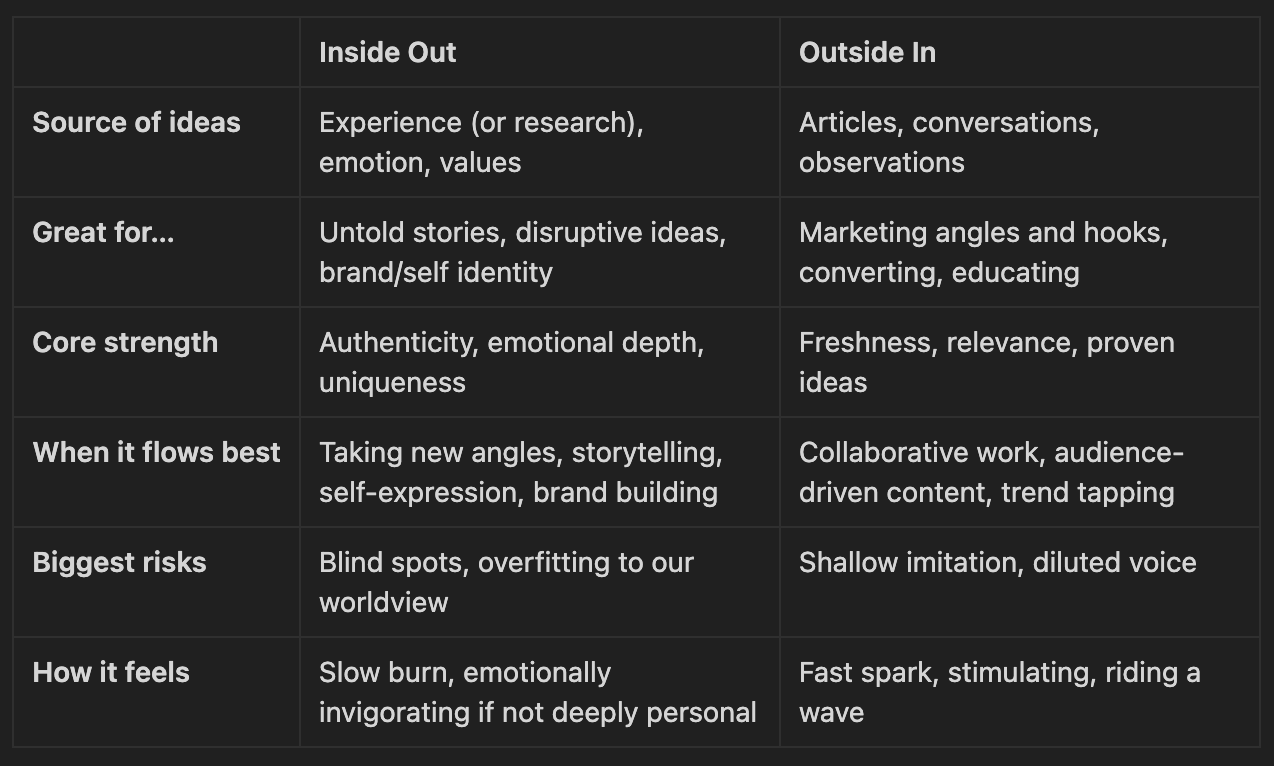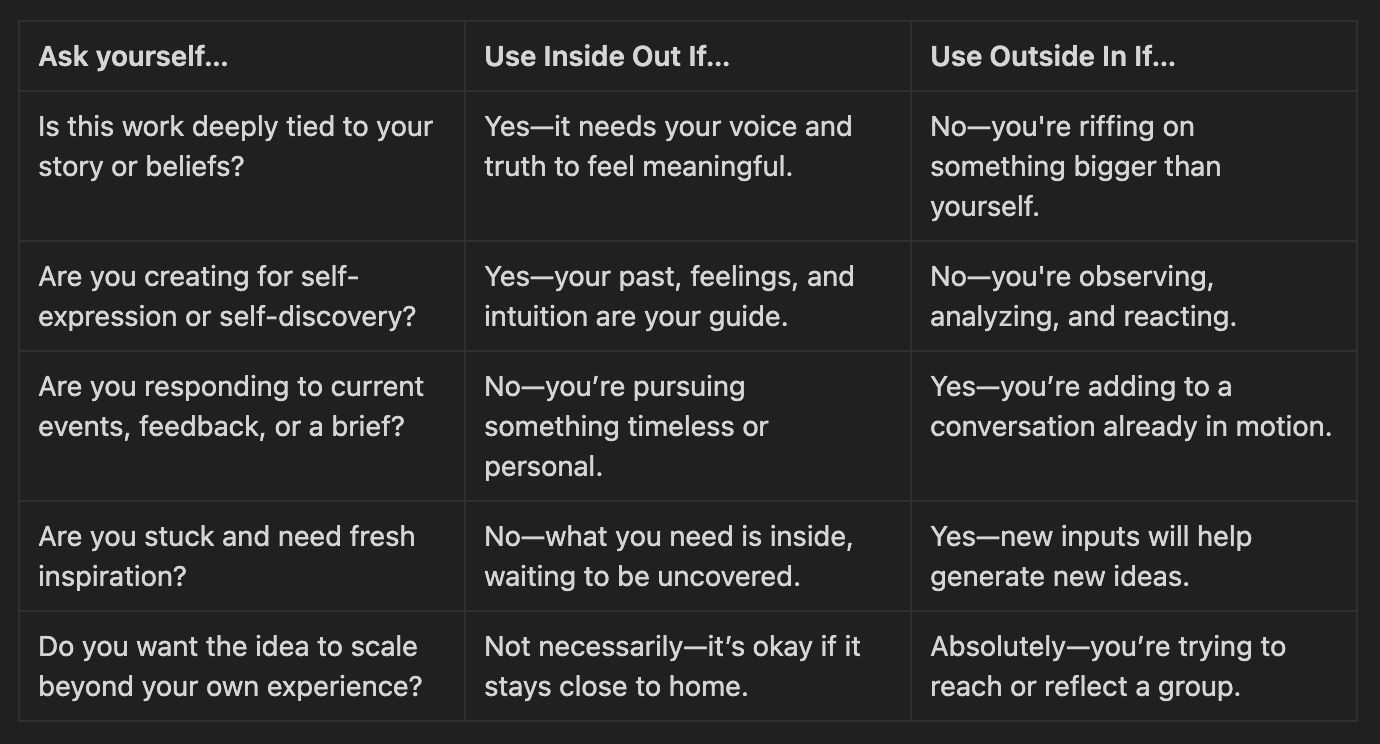The two paths to creativity
Every creative idea originates in one of two ways ("inside out" or "outside in"). The better we understand the path an idea takes, the stronger the work we create.
The origin of an idea means something.
A lot of traditional creativity advice zeroes in on what you make, while glossing over a critical area: where ideas actually spring from.
Understanding the origin of an idea shapes how we develop our projects, how we communicate our narratives, and ultimately, how authentic and original our work becomes.
In this post, we’ll dive deep into the two primary paths for new ideas—inside out and outside in. Each offers unique advantages and challenges, depending on the reasons we’re enlisting our creativity in the first place.
Key Takeaways
There are two paths to creative ideas, each offering benefits and drawbacks, and understanding the origin of an idea allows for more intentional crafting
“Inside out" ideas emerge from and are built upon personal experiences or collected knowledge
"Outside in" creativity draws inspiration from the external, often repurposing or recycling what works, but in new ways
Identifying the source of your ideas early can help us better nurture those ideas, and breathe life into into them in a way to speaks from our core values.
Let’s explore these two creative paths.
Inside out creativity: When your ideas come from within
Some of the most resonant creative work starts from gut feelings, core truths, or asynchronous revelations. Inside out creativity is the path of drawing from your base. That base can be past experience, emotional memory, personal beliefs, or collected knowledge.
Examples of inside out creativity look like:
A founder building a tool from pain points they’ve had for years
A songwriter pulling lyrics from the breakup they never wrote about
A designer reimagining a product based on known behaviors or audience triggers
A novelist drawing on the unspoken dynamics of their childhood
These ideas don’t just come from curiosity—they bubble up out of lived knowledge. That’s often what makes them so sticky.
Why choose the inside out path?
Authenticity hits more heavily. People can feel when it’s real.
It’s more sustainable. You’re pulling from a deep well, not chasing trends.
You’ll create things with soul. And soul tends to travel.
When to be careful
Inside out doesn’t mean ignore the world. And one of the risks is that it might trap us in our own assumptions if we:
Miss broader relevance from untested (or lightly tested) ideas.
Mistake short-term catharsis for long-term value.
Conflate personal importance with audience resonance.
When it works best
Use inside out creativity when:
You’re writing something personal (essay, memoir, novel)
You’re creating a product for people like you
You’re defining a brand or voice
Authenticity is of the utmost importance
It’s not only a way to find your voice—it’s the only way to make something only you can make.
Outside in creativity: When your ideas start with the world
Not all great ideas come from quiet reflection—some begin in the noise. Outside in creativity is driven by stimulus: the article, the viral outburst, the time-tested structure. At it’s core, it’s the sincerest form of flattery.
Examples of outside in creativity look like:
A designer creating a concept after seeing a museum exhibit
A marketer reworking website messaging that a competitor has nailed
A writer reshaping their novel pitch after reading another’s success story
A songwriter structuring a musical arrangement after a song they admire
A founder adapting their pitch deck to mirror the narrative structure used by a winning YC team
These aren’t copied ideas; they’re re-spun. Something else (maybe something successful) grabs us, and we refine it with our lens.
Why choose the outside in path?
You generate faster. Having an idea of what we’re going for gets us there faster.
You give your audience what they expect. There are types of content where defying expectation works against you.
You can crowd-source what works. We work from previously tested ideas or structure.
When to be careful
But just like the alternative, external inspiration has its traps:
Mimicking others is the quickest path to losing your voice.
Repurposing what works has a shelf life.
There’s a greater risk of being seen as unoriginal (or a copycat)
When it works best
Use outside in creativity when:
You’ve seen first-hand what resonates with a specific audience
You’re in try-it mode and want to find new things that work
There’s a ‘table stakes’ aspect to the content you’re creating
In short, outside in works when you know the WHY, but you’re playing with the what and the how.
Why this matters in the age of AI
In the past, your creative raw material had some natural friction. It came from long walks, life experience, conversations. You lived something before you could turn it into something.
Now? The inputs are infinite. Models, in some ways, have inspiration, mimicked voices, and common structure baked in. Which means the stakes for originality are quietly rising.
Here’s what’s on the line:
Creative Integrity: If you're not careful, you start sounding like a combination of inputs, rather than someone with a point of view. There's a difference between influence and inheritance.
Ethical Authorship: The more we build on someone else’s work, the greater the scrutiny (both internal and external).
Signal vs. Noise: The world needs more ideas that feel made, not recycled. The origin of an idea has a strong connection to how authentic it reads.
So how do we choose the right path?
It helps to remember that this is a spectrum. Many an idea percolates and is formed when we apply a little of both. But deciding the path to take for any given creative idea is a factor of two things:
Where we’re at in the moment (creatively stalled or flush)
The place and purpose for our output
Here are little bit of a decision guide you can consider when choosing whether outside in or inside out will work better for a given idea.
There’s no mistaking it, blending both paths is an art. Great creations harmonize the rich inner world with the colorful outside one. But recognizing where ideas come from goes a long way in striking the balance between authentic and effective.
How I can help
Whenever you're ready, here’s how I can help you:
Level up with 1:1 coaching: Get tailored support in prompt design, creative workflows, or AI strategy. Whether you're a writer, leader, or product thinker, I’ll help you use AI to create faster and smarter—without losing your voice.
Book a team training or executive workshop: From half-day bootcamps to role-specific trainings, I help teams unlock practical use cases, establish smart guardrails, and build momentum with clear, no-jargon frameworks.
Grab my Prioritization Power Stack: Not ready for coaching or consulting? Check out the first in my library of plug-and-play prompt packs—a closed-loop productivity system that eliminates busywork.


